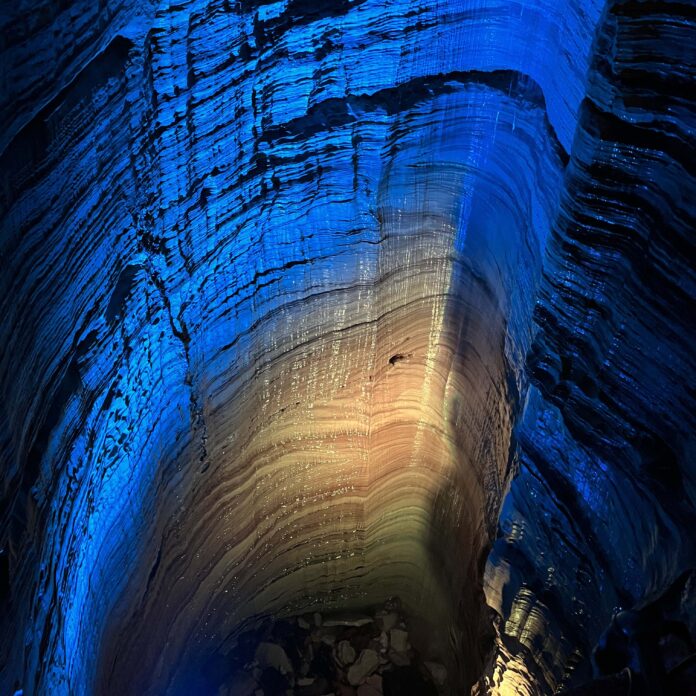
The main reason I had chosen Carter Caves State Park in Kentucky as a destination was because of the variety of cave tours offered. Also, after spending three days at Mammoth Caves in western Kentucky, it was right on our route to our final stop at New River Gorge in West Virginia.
The previous day was spent hiking and setting up camp, so we dedicated the second day to a cave tour. The park had many different options for exploring caves differing in length and difficulty.
Cascade Cave

We chose to visit Cascade Cave because it was an average length of 75 minutes, not too short but not two hours in length either. Several members of my family, I won’t mention any names, did not want to crawl through tight passageways.
I thought I would be okay with more constricted tours, but I was also happy with walking in more spacious caves. I was also swayed into choosing Cascade Cave when I read that there was over a 30-foot underground waterfall on the tour.
My husband and I purchased our tour tickets at the visitor’s center and then had to rush back to the camper to pick up the kids. I had chosen an earlier time so that we would be back by lunch.
When my kids were little, I often compared rushing them to herding chickens. The sudden hurry to get to the location of the cave tour reminded me a lot of the chicken herding days. There was squawking and pestering but we made it just in time to the cave which was located a little under three miles from the campground on the Cascade Caverns State Nature Preserve.
A state park ranger was waiting and ready to lead our small group of 12 people to the opening of the cave. Our tour at Mammoth Cave had over 100 people. I was immediately more comfortable with the small number in our group. It made asking questions about the caves easier and allowed for more interaction during the tour.
I could not get over how green the forests were in Kentucky. Between abundant ferns and groves of paw-paw trees, the forests were vibrantly green. Karst topography was evident in the area like when we were in the western part of the state.
Chemical and mechanical erosion within the layers of limestone bedrock created the cave passageways. A group of rock outcroppings and plant life surrounded the cave opening which was blocked with layered rock and a locked metal door.
Calcite crystals
The ranger led us into the first large chamber of the tour. He explained that the locked door was used to stop vandalism to the unique features of the cave. As we stood in the large chamber, the ranger pointed his flashlight at calcite crystals.
Condensation rich in carbonate forms a layer of film over stalactites and stalagmites which crystallize over time. The presence of calcite crystals is an indicator to cave explorers that they are near an entrance. Outside air has to mix with air from below ground for the crystals to form.
The ranger was unable to shine his flashlight directly at the next area of interest. A cluster of bats hung from the ceiling of the cave. About the size of a chicken nugget, the small bats were nestled together as a group.
After the outbreak of white-nose syndrome, the bat population in the park shrunk to about 10% of its previous numbers. At least five species of bats including the common Indiana bat live in the caves at Carter Caves State Park.
We were standing in the area known as the Dance Hall. Historically, tourism brought in a lot of money to cave owners across the state. Attempting to make more revenue, owners sought to attract more visitors with special events in the caves like square dancing. Currently, the park uses the room for special showings of movies for up to 300 people.
As we continued walking in the cave system, the ranger casually mentioned snakes as we entered an area known as the Lake Room. My daughter turned around and looked at me with very wide eyes.
Snakes curl around the stalactites on the cave ceiling and wait to drop on an unsuspecting mouse or mole. I tried to stop myself from visualizing hanging snakes and instead focused on the water to our left.
We were walking around a reflection pool. The water is aquamarine when it is exposed to light. There was light from outside casting a glow on the water where an underground river exited the cave in another small rocky opening.
Cascade Falls
The final stop of the tour brought us to Cascade Falls. The 30-foot-plus waterfall was illuminated with multi-colored electrical lights.
Due to the narrow passageway, we took turns walking up to the waterfall. I stepped up to the ledge and looked up and down at the falling water and the evidence of erosion over time.
The ranger giving the tour explained that the source of the waterfall is a mystery. Using dye, studies have shown where the water travels to after the cave, but they cannot determine its source. It was a great end to our tour of the caves at Carter Caves State Park.
That evening we hiked to several more natural arches before squeezing in some stargazing. We also packed as much as we could in preparation for traveling in the morning. With a few hours to drive, we were hoping to make it to New River Gorge early with time to explore the next day.












